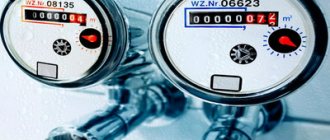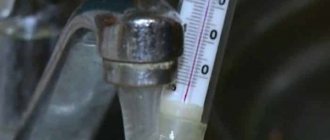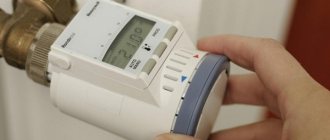What does it consist of?
It consists of:
- Temperature sensors.
- Power supplies.
- Calculators that calculate the heat spent on heating a house.
- Flow meters that calculate the volume of coolant in the system.
The parameters collected by the device are automatically sent to the computer, which determines the temperature difference over a certain time interval. The error is no more than 2.5-6% .
When vertically distributing the heating system in MKD, calculators and heat distributors are used
There is a misconception that when installing vertical heating, it is technically impossible to take into account the amount of thermal energy consumed. In fact, there are two ways to keep track of heat energy in apartment buildings with vertical wiring:
- Heat calculators installed on radiators.
On the territory of the Russian Federation, “Techem” heat calculators are certified, taking into account the amount of energy produced by an individual heating device in kW/hours, which, if necessary, can be converted into gigacalories (Gcal).
Techem calculators are heat meters. They are installed and used to record individual consumption in a separate MKD apartment. These devices can be combined into a single network and automatically transmit data to the server of the organization managing the apartment building.
Techem computer for heating radiator
Please note that installing computers in a separate MKD apartment is unprofitable. In this case, when paying for heating in the house, the component of the payment for one-room heating increases significantly, and the total amount of the receipt remains the same. The only way out is to equip all heating appliances at home with computers. The work can be carried out at the expense of the capital repair fund, additionally organizing a system for remote readings.
- Heat cost allocators.
When vertically distributing a heat supply system in an apartment building, heat cost allocators are also used today. There is a condition: for individual metering, at least 50% of all premises in an apartment building must be equipped with these devices.
Heat cost allocator
Distributors are much simpler and cheaper than IPU, and are not heat meters. Outwardly, they are similar to calculators, with the only difference being that they calculate the share of heat costs for an individual heating device. The sum of these numbers in a separate room is the room’s share in the heat costs of the entire house. Based on them, it is calculated how much percent was spent on one premises and how much on another, and thus accruals are made.
Let us note that since 2012, developers have been required to equip new buildings with individual heat meters, and they install just such heat cost allocators in apartments.
The calibration interval for both calculators and distributors for vertical heating distribution is 12 years. And when the MPI expires, they are replaced with new ones.
Is there a fee for sealing the IPU established by the owner?
45292
What influences the price range?
There are two decisive factors: manufacturer and type of equipment . Everything is clear with the manufacturer - the cost of the product is directly dependent on the technologies used by the plant. But the type of heat meters directly affects the performance characteristics, and therefore the cost of the product.
The equipment will differ in design features and data reading method . These differences directly affect the ability to install the device on a specific high-rise building.
Affects pricing and service life. Devices that will last from 2 to 4 years less, but the savings, in this case, are questionable. The design, installation and commissioning of the device are not free pleasures, so paying for them every 3-4 years is impractical. Considering that the average payback period for individual devices is at least three years, their purchase becomes economically unprofitable.
How to install a communal heating meter
The law believes that a heat meter should be installed in almost every home. It is necessary to install a heat meter in every home. But there are some exceptions. The list of houses that can function without heat meters includes emergency buildings and houses where the cost of the device is higher than the payment for heating for six months.
A heat meter is needed for fair distribution of payments and stimulation of tenants' responsibility. Insulating the house will reduce the cost of heating.
Residents themselves are required to pay for the installation of devices. This raises questions: is it profitable to install heat meters? Savings are only possible if the house is well insulated.
Installation procedure for heat meters:
- Drafting the project;
- Obtaining permits;
- Installation of the device;
- Counter registration;
- It is necessary to check the functionality of the unit and draw up the necessary documentation.
The need to install a meter is determined at a meeting of residents. It is also necessary to raise funds for the installation of equipment. Then contact a qualified company. Subsequent verification and, if necessary, repairs are carried out by the same organization.
Types of ODPU
Household metering devices are divided into:
- Tachometer.
- Vortex.
- Electromagnetic.
- Ultrasonic.
The first ones are arranged quite simply. Hence their low market value - from 6,000 to 10,000 rubles . However, to install tachometer models you will additionally need to purchase: a magnetic-mechanical filter, shut-off valves and fittings.
Vortex devices are distinguished by the fact that they are mounted on both vertical and horizontal sections of the system. Equipped with a special battery, which reduces energy consumption. The battery will provide 5 years of trouble-free service life. The average cost of such devices is 15,000 rubles . It should be taken into account that the heat meter is sensitive to contamination, so for stable operation of the unit you will need to purchase a filter.
Electromagnetic varieties are the most economical. Their presence can save up to 50% of money in the consumer’s pocket, but in return you will have to regularly invest in maintaining the DPPU. The presence of impurities in water can lead to breakdowns, and, as a result, incorrect performance of the device and overpayments. The cost of the mechanism is 15,000-17,000 .
Ultrasonic systems are recommended to be installed in new buildings where the heating supply is not clogged with deposits. They take readings by passing an ultrasonic wave through a coolant flow. Current cost is from 15,000 to 48,000 .
Prices are indicated without taking into account the cost of developing design documentation, installation, commissioning and other individual features of residential buildings, which may lead to an increase in the cost of the procedure.
Who should install a communal heating meter, advantages of installation
Installation is carried out by specialists hired by the housing and communal services service of the house. Residents of the apartment building pay for the installation. A common building meter records the total amount of heat that enters the high-rise building. That is why it is worth understanding in more detail the benefits of such a device.
Advantages of using a common house meter:
- You can save on equipment, since self-installation will be quite expensive. The cost of a common house appliance is shared among all residents.
- Everyone will now use heat more carefully. Residents will be more responsible about open entrance doors or a damaged window.
The disadvantages include the high cost of the device. In this case, the device may fail, and the residents will again have to pay for its repair. But the main disadvantage is the inability to save on heating the apartment due to lower consumption of thermal energy.
The need to install a meter is determined at a general meeting of residents. After a written application to the relevant organization, the device is installed.
To calculate the heat consumed, take the meter data and divide it by the area of the room. Of course, there are certain benefits from installing such meters. Otherwise, payment would have been made at inflated rates. But at the same time, it is impossible to regulate the heat supply, which is a significant disadvantage.
What the law says
Heat meters and their use are regulated by laws, for example, this is the regulatory act 261-FZ “On energy saving and increasing energy efficiency and on introducing amendments to certain legislative acts of the Russian Federation.”
It says that buildings and other real estate objects that use energy must have meters for these resources, including individual heat meters.
And the owners of these accounting devices must ensure their safety, normal condition and, of course, change them on time.
There is also Federal Law 190-FZ “On Heat Supply,” and its Article 4 states that it is simply prohibited to commission heat sources and connect new consumers without installing meters.
In addition, the responsibility to install them lies with consumers, who must operate them themselves or under an agreement concluded with companies.
If an apartment building is put into operation now, then the meters must be installed by the developer before permission to legalize the house.
Reconciliation of readings from a common house heat meter
To calculate monthly payments, accurate and timely readings are needed, which are taken from the general building meter. In accordance with Decree of the Government of the Russian Federation dated May 6, 2011 No. 354, responsibility for heat metering lies with the utility service provider, which can be:
- Management Company;
- HOA;
- Housing cooperative;
- resource supply organization.
Meter readings are taken monthly from the 23rd to the 25th of the current month. The ODPU service agreement may contain a clause on the presence of a representative of the residents when readings are taken.
If there is no such condition, then, at the consumer’s request, the contractor is obliged, within one working day, to acquaint him with the instrument readings recorded in the ODPU reading log. This document is a kind of reporting to consumers and answers the question of how to check the readings of a common building heating meter.
Data storage period is 3 years. In cases where meter data is transmitted remotely in electronic form, the consumer has the right to request a screenshot of the readings recorded by the modem.










